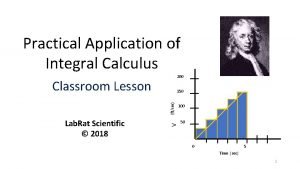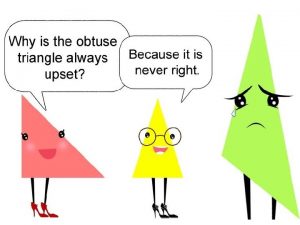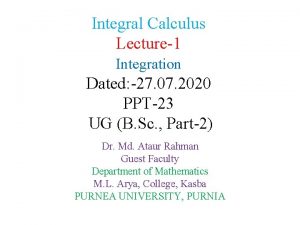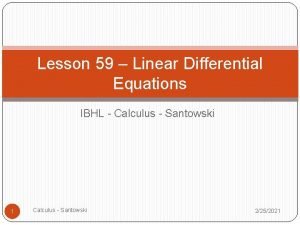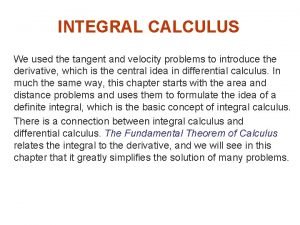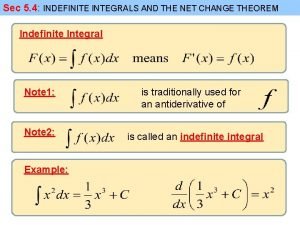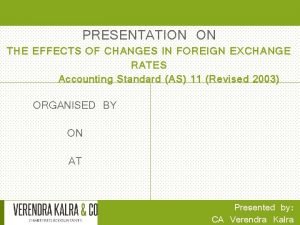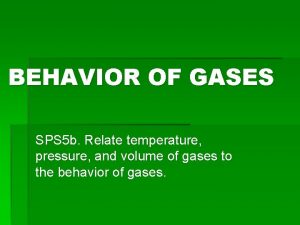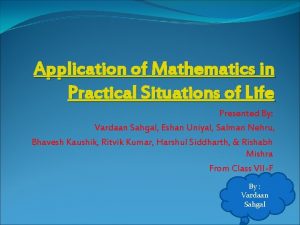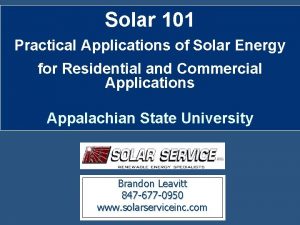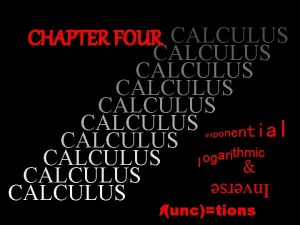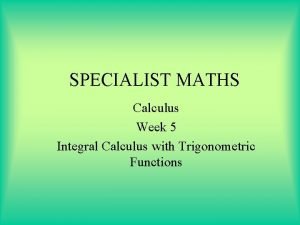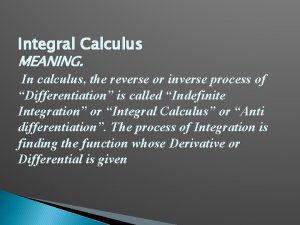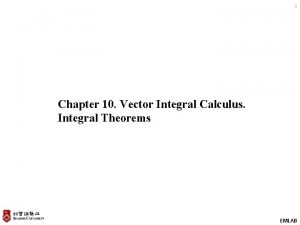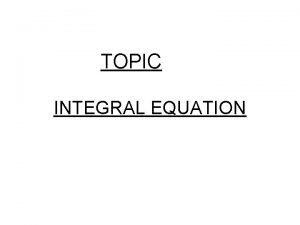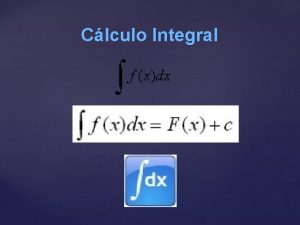Practical Application of Integral Calculus 200 Classroom Lesson





















- Slides: 21

Practical Application of Integral Calculus 200 Classroom Lesson Lab. Rat Scientific © 2018 V (ft/sec) 150 100 50 0 5 Time (sec) 1

Calculus Derivatives: A mathematical means to determine the slope of a line at any given point Integrals: A mathematical means to determine the area under a curve between two points This lesson will focus on the practical application of the “integral” and how it can be used to predict the motion of objects. 2

High school calculus classes can have a tendency to focus heavily on the process of calculating derivatives and integrals for complex equations. This can involve tedious processes and time consuming memorization of countless rules. Because of the tedium of learning the complex processes and the time it consumes, it can be very easy to lose sight of the fundamental purpose of the derivative and integral… This lesson serves as a reminder of the practical power of the integral. 3

What does “area under the curve” imply? Let’s start off by examining a go-cart that is accelerating at a constant 3. 0 ft/sec 2. a (ft/sec 2) Before we even worry about the acceleration curve (a. k. a. function) itself, lets take a look at the units of the X and Y axes. In this case, the Y-axis is Ft/Sec 2 and the X-axis if Sec. Y=3 0 5 Time (sec) A constant acceleration is a horizontal line on the acceleration plot 10 4

What does “area under the curve” imply? Now let’s “integrate” the function between the limits of 0 (zero) and 6. In the case of our acceleration example, that between 0 sec and 6 sec. This is depicted by the YELLOW rectangle. a (ft/sec 2) “Integrating” the function means we are going to calculate the area under the acceleration curve just as the go-cart begins accelerating (T=0) and 6 seconds… Y=3 0 5 Time (sec) 10 5

What does “area under the curve” imply? In this simple case, we can use simple geometry to calculate the area of the YELLOW area. The are of the rectangle is obtained by multiplying the “base” by the “height”. That is just simple geometry… a (ft/sec 2) We can’t forget that the base and height have “units”. If we multiply ft/sec 2 times sec, you will notice that the result is ft/sec, which is the units for velocity. Y=3 A=B*H A=3*6 A = 18 0 Units = ft/sec 2 * sec = ft/sec 5 Time (sec) 10 6

What does “area under the curve” imply? From this, we can see that the area under an acceleration curve is velocity (ft/sec)… This is kind of profound, if we integrate an acceleration curve, we get velocity. a (ft/sec 2) If we apply the same thought process to the resulting velocity curve, we would see that the integral of velocity is distance (ft). Y=3 0 5 Time (sec) 10 7

If we can calculate the velocity and displacement by integrating an acceleration we can calculate the motion of an object (integrating with respect to “time). Or, if we know the heat input for every length along a jet engine, we can calculate the temperature of the gas as it moves though the combustion chamber (integrating with respect to “distance”). 8

Let’s apply this simple concept to a real world problem where acceleration is a constant – A free falling body… Acceleration = a = 32. 2 ft/sec 2 9

The Free Fall Example Constant… a Let’s say we want to know how fast a rock will be moving after it has fallen for 5 seconds. (ft/sec 2) 32. 2 0 200 161 ft/sec (ft/sec) 150 100 V We simply multiply the “height” (32. 2 ft/sec 2) by the “base” (5 sec) and we see that the rock will be traveling at 161 ft/sec. 5 Time (sec) 50 0 5 Time (sec) 10

Comparison to the Analytical Solution We can apply the most basic rules of analytical calculus to compare to the results of the geometric approach. From calculus class: ʃtn t (n+1) dt = ---- + C (n+1) ʃ c dt = c ʃ t 0 dt a = 32. 2 Ft / Sec 2 V = ʃ a dt = (= constant) a ʃ t 0 dt t(0+1) = a x ( ------ ) = 0+1 = 32. 2 Ft / Sec 2 a* t 1 x 5 Sec = 161 Ft/Sec 11

200 V (ft/sec) You should notice that the velocity curve forms a triangle. At T=0 the velocity is zero. At T=5 the velocity is 161 ft/sec. 150 100 50 To determine how far the rock falls, we just need to calculate the area of the resulting triangle: 0 5 Time (sec) 402. 5 ft Area = ½ x Base x Height Distance = ½ x 5 sec x 161 ft/sec = 402. 5 ft/sec Dist (ft) 400 300 200 100 0 Time (sec) 5 12

Comparison to the Analytical Solution We can apply the basic rules of analytical calculus again to verify our geometric distance calculation. Dist = ʃ Vel dt = ʃ a t 1 = a ʃ t 1 = a x t (1+1) -----(1+1) = ½ a * t 2 = ½ x 32. 2 Ft / Sec 2 x (5 Sec)2 = 16. 1 Ft / Sec 2 x 25 Sec 2 = 402. 5 Ft 13

Experimental Proof Let’s prove that this computational theory really works. Let’s determine how long it will take a ball to hit the ground after being dropped from a height of 6 feet. We will use the equations that were determined analytically on Sides 11 and 13. Velocity = Acceleration * Time Distance = ½ * Acceleration * Time 2 Now, this example is a little different because we know how far the ball will fall (6 Ft), but we don’t know the fall time. We use the distance equation, but apply some basic algebra rearrange the equation so we can solve for the fall time. Distance = ½ Acceleration * Time 2 = 2 * Distance / Acceleration 14

Experimental Proof Time 2 = 2 * Distance / Acceleration Time = 2 * 6. 0 ft / 32. 2 ft/sec 2 Time = 0. 61 Sec This is theoretical fall time of the ball. A simple drop test can be conducted to see if this theoretical solution is correct… 15

Experimental Proof This is a rather simple experiment – simply drop a ball from a height of 6 feet and time how long it takes for it to hit the floor. Unfortunately 0. 61 seconds is not very long and it may be difficult to get an accurate fall time using just a stop watch. Of course, you could make 10 or 20 drops and take an average time and should get a reasonable result. However, a smart phone video could be analyzed on some simple video editing software to determine a pretty accurate fall time. Try the experiment… 16

A More Complex Problem - Predicting Rocket Motion A free falling ball is a rather simple example with a very simple mathematical function, but the same theory applies to more complex situations. One example is the acceleration of a rocket. If we know what the acceleration is (from F=ma, the rocket motor thrust, drag, and gravity), we can integrate the curve to get the rocket velocity, and then integrate the resulting velocity curve to get the rocket’s displacement. a (ft/sec 2) Acceleration of a rocket 0 5 10 Time (sec) 17

Predicting Rocket Motion Unfortunately we generally wont have the “equation” for the rocket’s acceleration curve, so “analytical” integration will be problematic. However, we can apply a method called “numerical” integration. a (ft/sec 2) Acceleration of a rocket 0 5 Time (sec) 10 18

Numerical Integration a (ft/sec 2) If we know theoretical thrust, weight, and drag acting on the rocket at any given time we can calculate the rocket’s theoretical acceleration via F=ma. Acceleration of a rocket 0 5 10 Time (sec) Numerical integration is the process where the instantaneous acceleration is calculated, and that acceleration is then “applied” over a small sliver of “time”. This resulting rectangular area (ft/sec 2 * sec) represents a change in the velocity (ft/sec) of the rocket over that sliver of time. If we add all the slivers together as we move though time, we can determine the total velocity of the rocket. We then do the same thing to the velocity to determine how far the rocket has moved. 19

Numerical Integration In the interest of brevity, this lesson will not go into any more detail on the concept of numerical integration. However, refer to Lab. Rat. Scientific. com for a detailed lesson on the subject. 20

200 (ft/sec) V Questions? 150 100 50 0 5 Time (sec) 21
 Practical application of calculus
Practical application of calculus Scientific notation
Scientific notation What is calculus used for
What is calculus used for Integration calculus
Integration calculus Integral formula
Integral formula Integral of tangent
Integral of tangent Integrals
Integrals Integral citation
Integral citation Non integral citation
Non integral citation Integral permukaan adalah
Integral permukaan adalah Examples of non integral foreign operations
Examples of non integral foreign operations Kalkulus integral
Kalkulus integral Cse smart class
Cse smart class 200+200+100+100
200+200+100+100 200+400+600
200+400+600 100 + 100 = 200
100 + 100 = 200 200+200+100
200+200+100 100 200 300
100 200 300 100 200 300
100 200 300 Practical application of boyle's law
Practical application of boyle's law Eshan sahgal
Eshan sahgal Practical application of solar energy
Practical application of solar energy
